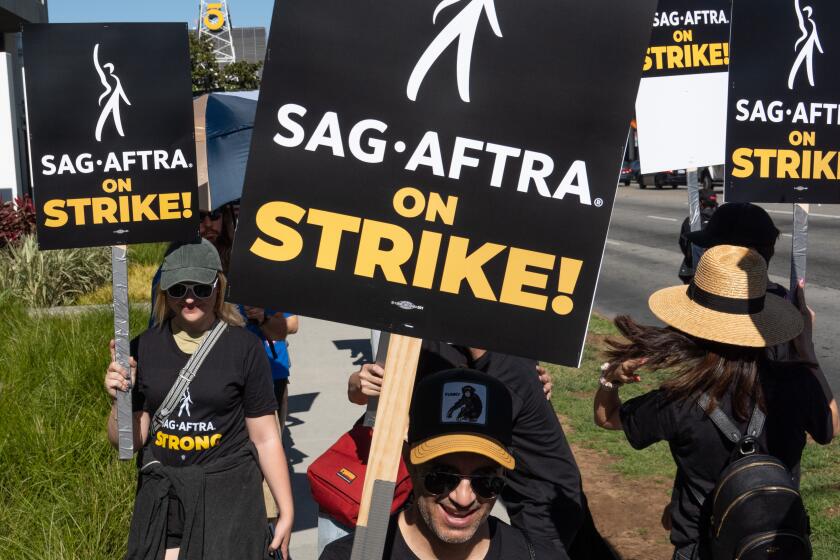New Low for Late Mortgage Payments
Rising real estate prices have helped push California’s mortgage-delinquency rate down to its lowest level in 25 years, an industry group said Thursday.
Many people who saw they were in danger of falling into arrears have been able to escape by selling their homes -- frequently for more than their purchase price.
Only 2.04% of the state’s homeowners were at least 30 days late on their home-loan payments in the fourth quarter, the Mortgage Bankers Assn. said. That was the lowest since at least 1979, the first year the group began keeping records. And the percentage of California households that fell into foreclosure in the three months ended Dec. 31 was 0.15%, the slimmest rate since for the fourth quarter since 1988, according to the mortgage bankers’ group. The foreclosure rate, however, was up from 0.13% in the third quarter.
A year ago, the state’s delinquency rate was 2.68%. It peaked in the fourth quarter of 1982 at 6.06%.
In California, “the pace of housing appreciation held down delinquencies and foreclosures because households that got into trouble were able to sell and take some equity” without having to hand their keys over to the bank, said Doug Duncan, the bankers’ group chief economist and senior vice president.
California homeowners have seen the value of their properties rise by 20% or more year over year in 10 of the last 12 months. In February, the median price of a California house or condominium reached $407,000, up 2% from January and 21% from a year ago, according to DataQuick Information Systems.
The still-climbing prices in February translated into a typical mortgage payment (principal and interest only) of $1,824, a new high, DataQuick found. That was 3.8% higher than the $1,756 in January and 24% more than a year ago.
Adjusted for inflation, mortgage payments are about 8% below their spring 1989 peak. In the last housing cycle, Southland prices peaked in 1991.
In the near term, delinquency rates are likely to remain near historical lows as the nation’s economy continues to expand, Duncan said.
What could change the delinquency scenario are rising mortgage rates; they have been steadily climbing since last fall. If rates edge higher, fewer people will be able to afford homes, which will slow demand and, ultimately, price appreciation.
The mortgage bankers’ group predicted that the average rate on the benchmark 30-year mortgage would reach 6.2% by the end of the year. This week, rates climbed to their highest level in seven months to 5.95%.
The last real estate boom bottomed out in 1997 as California home prices flattened and foreclosures rose to a high of 1.99% in the first quarter of that year. By the second quarter of 1997, prices started to increase again and haven’t stopped since.
One reason is the myriad types of mortgages available today. Adjustable rate loans and those requiring little or no down payment have given more and more borrowers -- even those with sketchy credit -- the opportunity to buy property.
When mortgage broker George Fecske started in the business 20 years ago, most buyers needed a down payment of 20% of the home’s purchase price to obtain a loan. “Now all you need to have is as little as 10% or less,” said Fecske, who owns GLF Mortgage Professionals in Los Angeles. “There are a lot of people getting interest-only loans with rates set for five years and they can barely afford paying for that.”
Nationwide in 2004, the share of new adjustable-rate loans was about 35% of all new loans, said Duncan of the bankers’ group. Of all loans about 11% are considered sub-prime. Sub-prime and adjustable-rate mortgages traditionally have higher delinquency rates, so the growing number of such loans might mean more loans entering foreclosure down the road, Duncan said.
Nationwide, the seasonally adjusted delinquency rate for mortgage loans stood at 4.23% at the end of the fourth quarter, the group said. That was down from 4.49% in the fourth quarter of 2003 and down from 4.41% in the third quarter of 2004.
One potentially worrisome statistic released Thursday was the rate of loans entering foreclosure in the fourth quarter. The seasonally adjusted rate nationwide was up 5 basis points from the preceding quarter, to 0.44%, the MBA said.
“It’s hard to call one quarter a trend,” Duncan said. “But given the growth in the size of the sub-prime component, and new adjustable-rate mortgage products, we want to pay attention to this.”
In California, the foreclosure process begins when a lender files a notice of default with the county after a borrower fails to make his mortgage payments. The owner may be delinquent anywhere from 15 days to 12 months, or more. After the default notice is recorded, the borrower and any other lienholders have 90 days to bring their account current. If the borrower doesn’t do so, the lender will authorize a foreclosure sale, usually at a public auction.
The bankers’ group’s quarterly survey tracks about 39 million mortgages nationwide on one- to four-unit residential properties across the U.S., accounting for about 80% of the total number of outstanding loans.
In the fourth quarter, California had the second-lowest delinquency rate in the nation. Hawaii had the lowest, at 2.02%; Mississippi, the highest at 8.80%. The state data aren’t seasonally adjusted.






